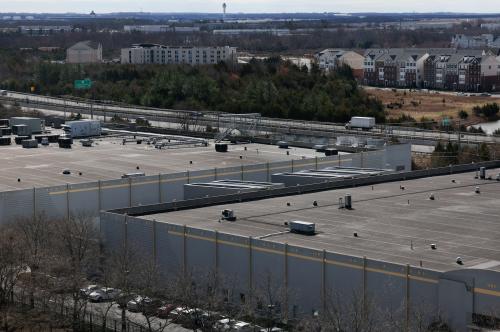A historic fiscal experiment in this country will evolve in the weeks, months and years ahead as a $790 billion stimulus package is spent to revive America’s economy. Metropolitan Policy Program experts suggest how this money might be strategically deployed to invigorate our nation’s metropolitan areas, the sources of national prosperity.
Mark Muro
, Fellow and Director of Policy
My hope is that the stimulus funding flows will occasion the emergence of stronger regional organization in metropolitan areas.
The conventional wisdom is that the package–with its haphazard collection of separate funding items, many to be allocated by states–will be frittered away in a random spending spree governed by business as usual. The fear is this will undercut rather than strengthen the emergence of cohesive metro regions.
However, few things would yield greater long-term benefit than if, in at least some areas, the administration of stimulus flows at the local and state level was pursued in ways that fostered metropolitan decision making—the key to national prosperity. Ultimately, this should be one of the signal goals of all federal policy as argued in the report “MetroPolicy.”
Along these lines, it would be optimal if a surprise outcome of the package is that it evokes new efforts by state and local leaders to aggregate and align the package’s myriad separate funding flows–for roads and transit projects, water infrastructure, weatherization, or various block grants—in support of metropolitan growth.
Signs point to that already happening in some places. The Chicago Metropolitan Agency for Planning is thinking hard about how to marshal the stimulus in ways that support metropolitan prosperity, and has posted draft criteria for project selection. In the Kansas City region, the Mid-America Regional Council is assembling a regional public works list so the region can advocate as a unified entity for its needs and make the most of the moment. And for that matter, Vermont, Ohio, New York, and Massachusetts have all appointed infrastructure or stimulus “czars” to oversee and organize stimulus spend-down, although not necessarily with metropolitan coordination in mind.
In short, let’s hope every state strives to insure that the stimulus package’s implementation is coordinated, integrated, and metro-focused. Ultimately the point here is economic growth, and growth emerges from cohesive, dynamic metros.
Robert Puentes
, Senior Fellow
The recovery plan will direct nearly $50 billion toward infrastructure projects designed to help put Americans back to work and boost the economy by rebuilding roads, bridges, mass transit systems, and investing in rail and ports. Given our nation’s outstanding investment needs, it is up to the states to ensure that projects focus on metropolitan areas which, as the nation’s economic engines, drive American productivity and prosperity and so are fundamental to national economic recovery.
Stimulus funds for the highway and road network should prioritize rehabilitation and maintenance projects especially in underserved areas. States should also consider the option of flexibly transferring funds to ready-to-go transit initiatives, non-motorized initiatives, and projects that decrease driving. Reducing vehicle miles travelled will help the nation achieve its energy independence goals, as transportation contributes one-third of the nation’s greenhouse gas emissions and is the fastest growing contributor to our carbon footprint.
To ensure we have the human capital to rebuild our nation’s infrastructure, states should set-aside a portion of funds for each project for job training programs, particularly those in partnership with community colleges or trade unions. Such programs can help stabilize low income communities and provide a pathway to good jobs.
The recovery package should send a strong signal and set the course for a new economy and a rethinking of transportation policy in this country.
Alan Berube
, Senior Fellow and Research Director
The economic stimulus/recovery package rightly directs much of its assistance toward where the dollars will be spent immediately on goods and services. In doing so, the package also aims to invest in several longer-term priorities that can lay the groundwork for higher future economic growth.
The package’s expanded tax credits for low- and moderate-income working families provide significant stimulus. In particular, increases to the Earned Income Tax Credit, or EITC, have been shown to help these families pay for necessities like housing, food, clothing, and school supplies, and durable goods like furniture and appliances. The expansions made to the refundable Child Tax Credit, and the creation of a new Making Work Pay credit, can further the same goal. Moreover, these expansions can help to fill some of the long-term wage/price gap that many of the nation’s lower-paid workers face.
The package also includes important assistance for lower-income communities where foreclosures threaten housing market viability and local fiscal capacity. A new, competitive round of HUD’s Neighborhood Stabilization Program will help mitigate the secondary impacts of foreclosures, employ local workers in occupations such as property maintenance and construction, and ultimately preserve asset values to facilitate market recovery and sustain quality places.
Finally, the package provides nearly $9 billion to states through a Fiscal Stabilization Fund, which they can use to modernize institutions of higher education. As states prepare to deploy these funds, they should keep in mind the value of investments in community colleges. These institutions face rising enrollments, sure to accelerate in an economic downturn, yet lack the capacity to serve students consistently well. Over the longer run, a larger, sustained federal financial commitment to two-year colleges, with dollars targeted to high performing institutions, would promote better outcomes for students, meet emerging skills needs, and enhance earnings for the American workforce.
The Brookings Institution is committed to quality, independence, and impact.
We are supported by a diverse array of funders. In line with our values and policies, each Brookings publication represents the sole views of its author(s).



Commentary
Op-edDelivering Metropolitan Stimulus
February 13, 2009